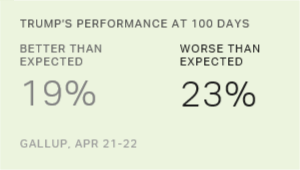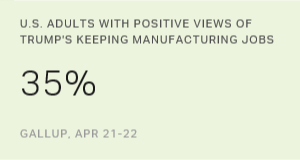Much of the discussion as President Donald Trump reaches his 100-day mark in office focuses on how the public grades his performance, both overall and on specific dimensions. A somewhat different approach is to assess how well he has done in terms of meshing with the American public's policy preferences.
Clearly, some of the president's actions do not reflect the policies about which Americans are most positive. Trump's energies on slashing the size of government do not meet with majority approval, even though the public has a low regard for government in general. Similarly, Americans are more negative than positive about the idea of building a wall, restricting those coming in from Muslim countries and restricting refugees, and break even when asked about a focus on pulling back from international trade agreements and efforts to repeal and replace the Affordable Care Act.
Many of these are complex policy areas with various nuances, but my analysis of public opinion data suggests that the president is fighting a lack of enthusiasm on each.
Trump does have some policy strong suits. Americans are quite positive about policies that are directly and obviously related to the creation or maintenance of jobs, investing in infrastructure, helping small business, helping veterans, making it easier for people to work, and providing tax cuts for middle- and lower-income people and for small businesses.
Trump's challenge is to look at these policies that play well with the public and figure out a way to connect the dots between them and the policies he is advocating. For example, the public's is not based on a lack of interest in border security, or necessarily on resistance to the idea of spending money. It's likely Americans are not enthusiastic about the wall idea because they don't see a direct benefit. If Trump could more convincingly argue that the wall will ultimately result in a lot more American jobs, for example, then he's onto something.
Americans strongly endorse . I presume Americans like this because it directly benefits them -- fixing potholes, bridges, tunnels, highways, airports -- and because it would create many jobs. The public presumably doesn't see these types of connections with building the wall.
Trade treaties? Our data show that Americans think rather than bad. Trump has to make the case here that somehow withdrawing from the Trans-Pacific Partnership and renegotiating NAFTA will result in more net jobs. He doesn't seem to have been effective at that so far.
Certainly the big news out of the administration in the final week before the 100-day mark has been Trump's initial outline of a tax reform plan. The idea of tax cuts plays well with Americans -- if those cuts are focused on lower- and middle-income groups or on small businesses, or are specifically designed to help create jobs.
But the idea of lowering taxes on corporations, a central part of Trump's current tax plan, has relatively low public agreement. For Americans, cutting taxes on small businesses is good; on big businesses, not so good, giving an obvious direction for what Trump should be emphasizing.
In fact, the president could fruitfully connect almost anything he does to small business, one of the most dearly beloved institutions in American society today. A number of policies we have tested over the last year and a half that refer to small business test well.
Trump's announced plan includes eliminating the estate tax, a proposal that earns significant positive support from Americans, even though the vast majority won't have an estate large enough to be affected by taxes when they die. His plan would also reduce the number of tax brackets to three instead of the current seven. Americans like a proposal we tested that involves cutting tax brackets back to four, suggesting that they would also like the idea of cutting them to three.
Trump has focused on "draining the swamp" in Washington and in that regard has initiated efforts to reduce federal regulations and cut back civilian hiring in the federal government.
While Americans have low esteem for the federal government, they simply are not all that interested in these types of wholesale government cuts. Americans are much more likely to disagree than agree with a proposal to eliminate two existing federal regulations for every new federal regulation and to put a hiring freeze on most civilian jobs in the federal government.
This is most likely because the public's enmity toward the government is than it is on the bureaucracy. And, while Trump has put forth some proposals that would affect members of Congress' ability to become lobbyists when they leave, these have not been his major emphasis. The data show that they should have been.
In general, over his first 100 days in office, Trump's policy proposals and actions have a mixed connection to American public opinion. In some instances, the president is simply out of sync with the public. But in others, the president has not managed to make the connection between a given policy and Americans' existing priorities, which tend to focus mostly on jobs and fixing the way Congress works.



